Top News
For my October dividend reinvestment, I added shares of SCHD, which I think is the best all-around dividend-growth ETF available.
Those new shares, combined with newly-announced dividend increases from several companies, took my annual dividend run-rate up to a new high of $6066 per year, which brought my yield on cost to 13%, also a new high.
Along with the market’s general decline, the DGP’s total value fell in September, almost exactly in line with the S&P 500.
Primary Goal: Generate Reliable, Growing Dividends Every Year
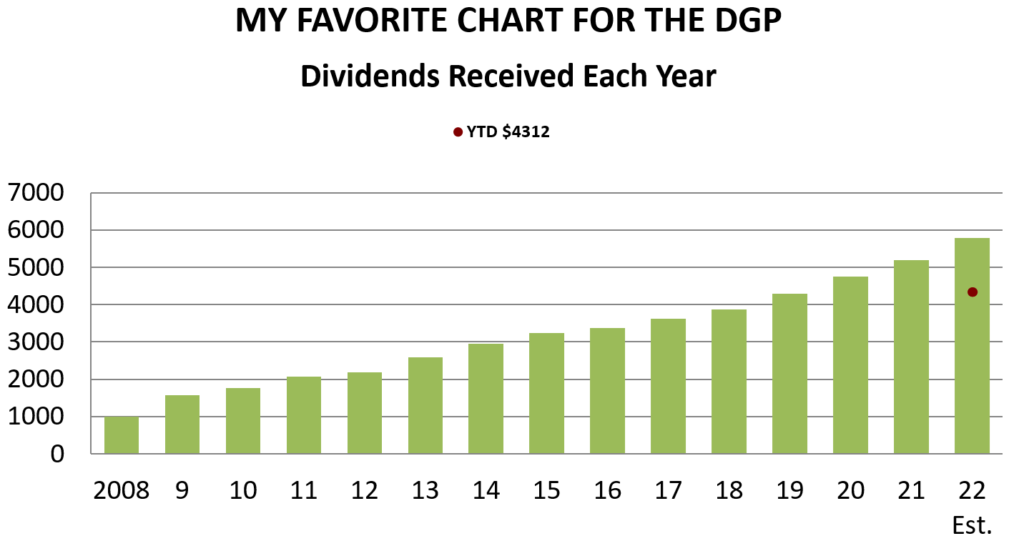 The primary goal for the this portfolio, as stated in its Business Plan, is to…
The primary goal for the this portfolio, as stated in its Business Plan, is to…
Build a reliable, steadily increasing stream of dividends over many years that can eventually be used as income for retirement.
As the chart above shows, that goal has been hit every year of the portfolio’s existence.
It will be achieved again this year. At current run-rates, 2022’s total dividends will exceed last year’s by more than 11%, as shown in the far-right green bar. The brown dot in the bar shows dividends collected so far this year: $4312. Note that amount is more than all the dividends collected in 2019, and there’s still three more months left in 2022.
Why the Portfolio’s Dividend Stream Grows Every Year
 There are three reasons that a dividend-growth portfolio’s dividend stream goes up every year.
There are three reasons that a dividend-growth portfolio’s dividend stream goes up every year.
- Dividend increases. The companies in the portfolio announce regular raises.
- Dividend reinvestments. The investor reinvests dividends and thus adds more shares, which produce more dividends. I collect my dividends and buy new shares each month.
- Portfolio management. I occasionally make trims and replacements that result in dividend growth.
So far this year, 29 increases have been announced, with a couple more expected before the year ends.
Dividend raises immediately grow the dividend stream as they are announced. As increases pile up, their impact becomes significant.
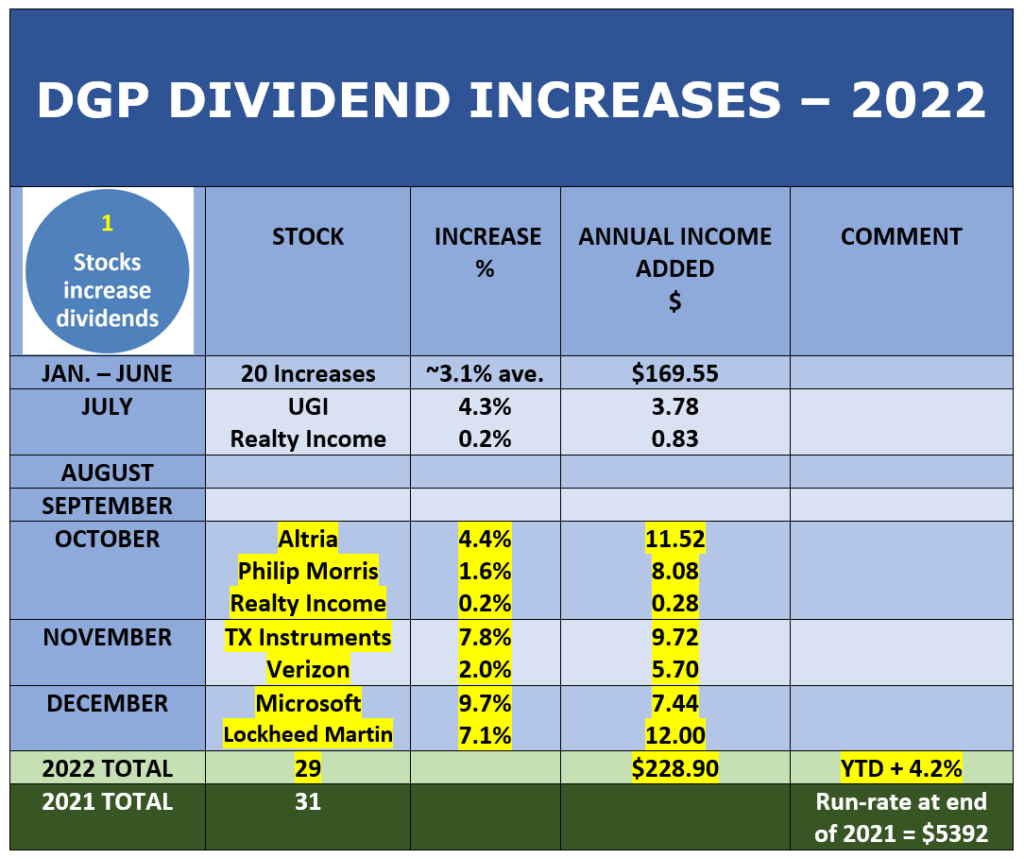 The yellow highlights are dividend increases since the last portfolio report plus the updated totals at the bottom.
The yellow highlights are dividend increases since the last portfolio report plus the updated totals at the bottom.
As you can see, 2022’s increases have added 4.2% to the annual dividend run-rate compared to the beginning of the year. This process goes on throughout each year, and over long time periods, it adds a great deal to the dollar value of dividends flowing into the portfolio.
October’s Dividend Reinvestment: Schwab’s U.S. Dividend Equity ETF (SCHD)
With the stock market tanking the past few months, many investors are reluctant to buy stocks at the moment. They fear more losses still to come, and many are exploring fixed-income opportunities – such as Treasuries, I Bonds, and CDs – whose rates have risen to become competitive with stocks.
However, in this portfolio, I keep investing no matter what macro conditions are. The noise from the market doesn’t bother me, because I’m focused on dividends, not prices.
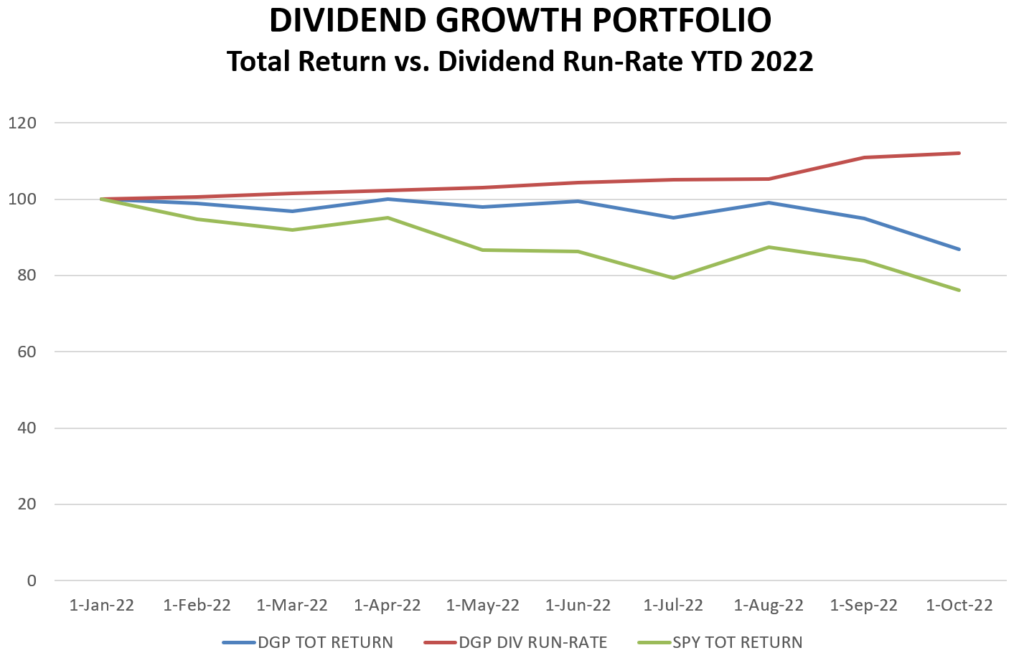 As you can see from this chart, dividends and prices are going in opposite directions. That happens because dividends are independent from the market. While both my portfolio and the S&P 500 are down from the beginning of the year (blue and green lines), my dividend run-rate is up 12% in 2022 (red line).
As you can see from this chart, dividends and prices are going in opposite directions. That happens because dividends are independent from the market. While both my portfolio and the S&P 500 are down from the beginning of the year (blue and green lines), my dividend run-rate is up 12% in 2022 (red line).
The market can crash, but dividends don’t crash.
That’s why, earlier this morning (October 3), I made this month’s regular dividend reinvestment: I purchased 9 shares of Schwab’s U.S. Dividend Equity ETF (SCHD).
In honor of the 9 new shares, let me give you 9 reasons why I selected SCHD as my monthly reinvestment for the 3rd time this year:
(1) I have analyzed and rated various dividend ETFs over the past several years, and SCHD has consistently been at the top of my rankings. For example, see this video from July (screenshot below), with SCHD sitting at the top of the rankings.
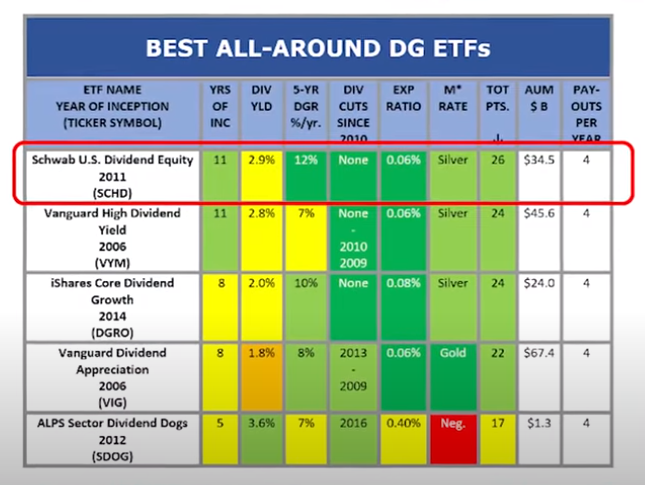
(2) Among dividend ETFs, SCHD has the longest dividend-growth streak – now 11 years long and likely to become 12 at the end of this year.
(3) Coming into 2022, SCHD’s 5-year annual rate of dividend growth has been 12% per year, tops among such ETFs.
(4) I have been focusing this year on my smaller positions (below 3% of the portfolio). Before this purchase, SCHD was just 1.6% of the account. This month’s purchase will push it above 2%.
(5) SCHD’s current yield is well above its historical norm, at 3.6% when I made my purchase.
(6) SCHD has never made an annual cut in its dividend since its inception in 2011. It appears to be on track to add another year to that record in 2022.
(7) SCHD doesn’t chase yield, a practice that can be a trap. While it favors stocks with good yields, it also applies several quality screens to every stock in its pool to weed out the weaker companies. Only high-quality stocks make it into SCHD’s portfolio.
(8) To promote diversity among its holdings, each stock’s weight is capped at 4% of the portfolio, and each sector weight is capped at 25%. The portfolio is re-set back to those limits every three months.
(9) SCHD is unusually well-valued right now.
Let me elaborate on the last point. ETFs are a pain to value, because the fund’s valuation really depends on the valuations of the stocks in it. For a fund with 100 stocks such as SCHD, that’s a lot of work. So I use a shortcut.
What I do is apply the “relative yield” metric – one of my valuation models – to the entire ETF. I want to know the fund’s current yield compared to its 5-year average yield.
Here’s a look at that for SCHD:
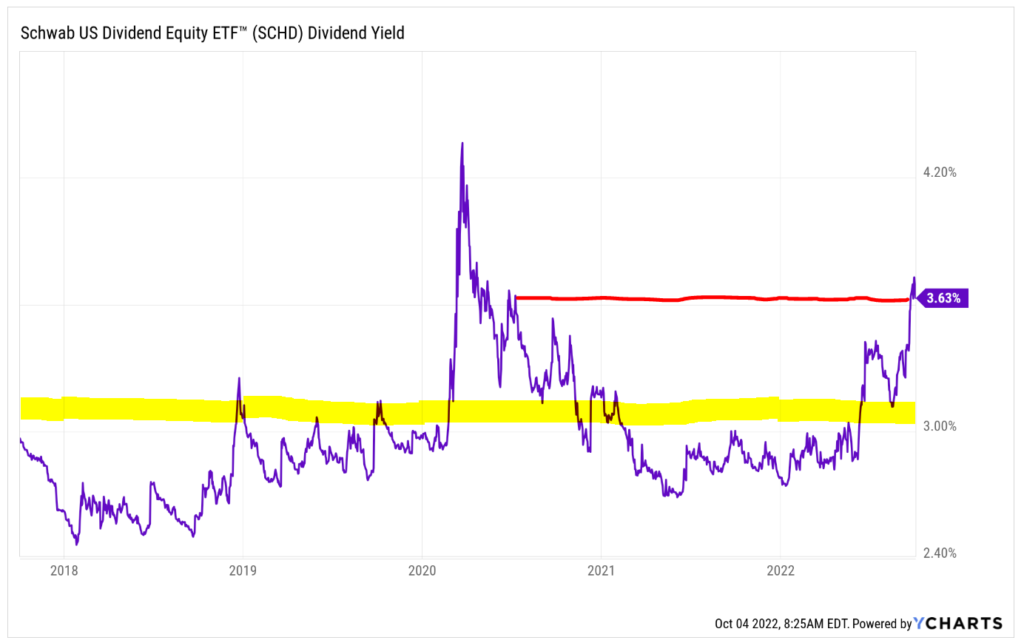 What this chart shows is SCHD’s yield over the past 5 years. To get the average, I simply eyeball the chart and draw the yellow stripe where I think the average approximately is.
What this chart shows is SCHD’s yield over the past 5 years. To get the average, I simply eyeball the chart and draw the yellow stripe where I think the average approximately is.
The average comes in at about 3.1%. The recent rise in actual yield (shown by the right end of the purple line) influences this number upwards.
When I’ve done this in the past, I’ve drawn the yellow stripe at about 2.9%. So my new estimate is more demanding. That’s fine – yields have been going up lately due to the market’s recent decline/crash, so higher yields are easier to find than they usually are. SCHD’s yield hasn’t been this high since the Covid crash in 2020 (red line).
When the current yield is higher than the 5-year average, that suggests good valuation. SCHD’s yield right now is 16% higher than its 5-year average.
Here’s the summary in E-Trade of my holding in SCHD. The yellow highlighted numbers at the top are totals for the position after this purchase. The current purchase is circled in red at the bottom. (The other lines show earlier purchases as I’ve built this position.)
 So for October’s reinvestment, I bought 9 shares of SCHD for $614. Now I own 46 shares, yielding 3.6% at today’s price. I added almost $23 to my annual dividend stream with this purchase, and my total annual income from SCHD rises to $117.
So for October’s reinvestment, I bought 9 shares of SCHD for $614. Now I own 46 shares, yielding 3.6% at today’s price. I added almost $23 to my annual dividend stream with this purchase, and my total annual income from SCHD rises to $117.
The position is now a little over 2% of the portfolio. That’s still a small position (less than 3%), so I will continue to add to it when good opportunties arise.
Remember that dividend reinvestment is Reason #2 that causes increases in the dividend stream. Here’s a summary of my reinvestments so far in 2022.
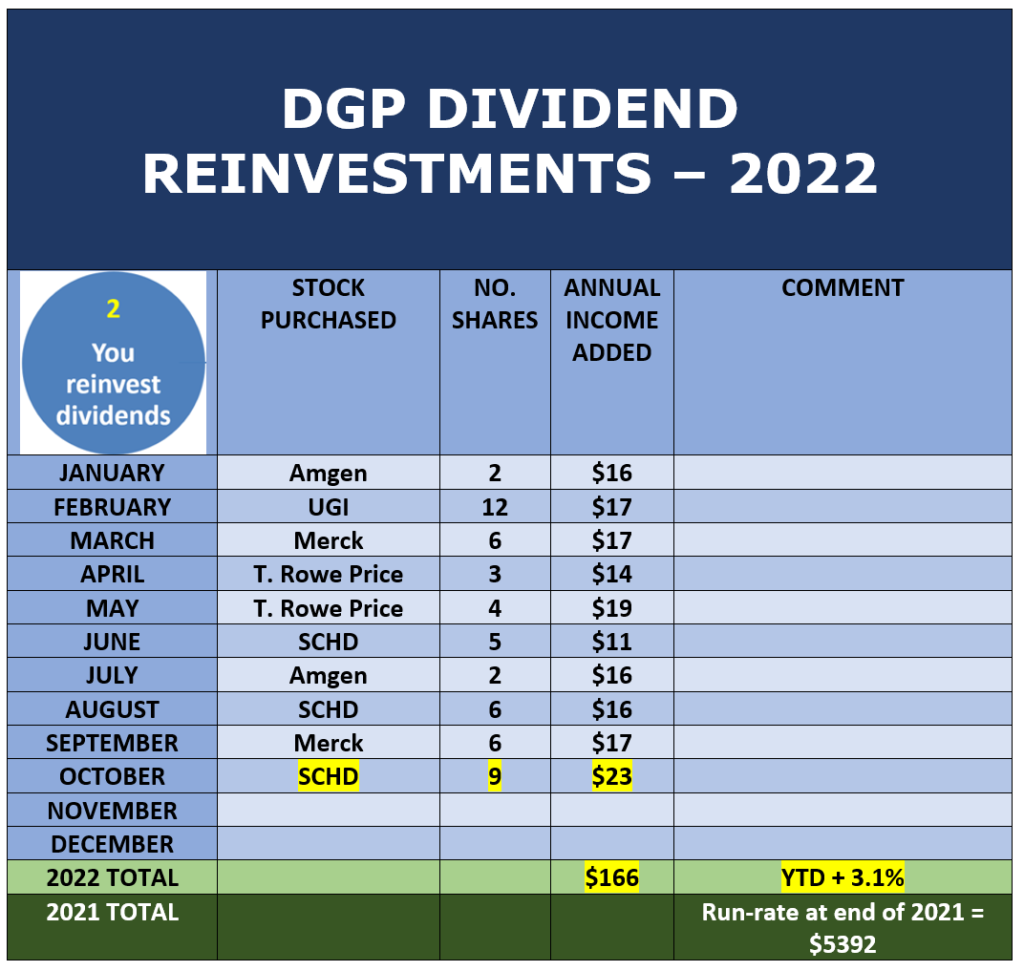 Again, as with dividend increases, the reinvestments pile up and add significantly to the dividend stream. Through September, my reinvestments have added $166, or 3.1%, to the annual dividend run-rate.
Again, as with dividend increases, the reinvestments pile up and add significantly to the dividend stream. Through September, my reinvestments have added $166, or 3.1%, to the annual dividend run-rate.
Portfolio Review
Now let’s switch gears and talk about the whole portfolio. The main point I want to make is that the DGP’s yield on cost (YOC) has hit 13% as a result of this month’s reinvestment.
What does that mean? Yield on cost is the portfolio’s yield calculated against the amount I originally invested to create the portfolio. I started the portfolio in June, 2008, with $46,783.
YOC = Dividend Run-Rate ÷ Original Amount Invested
= $6066 ÷ $46,783
= 13.0%
When I began the portfolio – while the market was crashing in the midst of the Great Recession of 2007-09 – its yield was around 4%. Now it’s 13% using the same denominator, because the dividend stream has risen to surpass $6000 annually. YOC mirrors the dollars in the dividend stream. As they go up, YOC goes up in tandem.
Yield on cost is a “scoreboard” metric, meaning that it shows how the game has gone up until now. YOC reflects the impact of every decision I have made – to reinvest, what to buy, when to trim, etc. – since I started the portfolio in 2008.
At 13% YOC, the portfolio is now sending me – in cash – dividends at the rate of 13% of my original investment per year.
That kind of income-generating power was the inspiration for the portfolio in 2008. My Favorite Chart, displayed earlier, shows the annual increase in dividends collected.
I hope that these real-world results are inspirational for younger investors who can appreciate the possibilities of large amounts of future income generated by modest investments made today.
By the way, I have not added any new capital since I started the portfolio in 2008. That’s why the denominator in the YOC calculation is unchanged from 2008.
The absence of new outside money makes the DGP a great demonstration of the power of investing this way. No results are skewed by new capital coming in.
Yield on cost is one flavor of yield. Another flavor is current yield, which is the yield from the portfolio right now, based on its current dividend run-rate and current value. It is the yield you would get if you duplicated the portfolio today at today’s prices.
Here is the formula for current yield as of October 3:
Current yield = Dividend run-rate ÷ Current value of portfolio
= $6066 ÷ $155,643
= 3.9%
In its 14-year history, the DGP’s current yield has ranged between 3.0% and 4.4%, swinging back and forth as prices go up and down. The current yield is near the high end of its historical range, mostly because of the steep drop in market prices this year.
For comparison to the DGP’s 3.9% current yield, the S&P 500’s current yield is 1.7%, and the benchmark 10-year Treasury (fixed income) is 3.7%. (Source)
A secondary goal of this portfolio is total return. I want to be competitive with a simple investment in the S&P 500. I’m not trying to beat the index, as total return is not my main focus. But I like to be in the same ballpark.
As of the beginning of October, the total value of the DGP has grown +225% from its inception in June 2008. It started at $46,783. It is now worth $152,016.
For comparison, if the DGP’s original money had been invested into SPY, the largest ETF that tracks the S&P 500, with dividends reinvested, it would have increased 239% to a total value of $158,594. (Source) The SPY investment would be yielding less than half of the DGP’s current yield (1.7% vs. 3.9% at the beginning of the month).
To see the complete portfolio as of October 1st, click here.
Remember, the DGP is not presented as best. It is not a model portfolio, nor is it tailored to growth, harvesting, or any particular age group. Rather, it is an all-around dividend-growth portfolio that demonstrates in real-life what you can accomplish with the dividend growth strategy. I show what I do and explain why I do it.
-–Dave Van Knapp
Where to Invest $99 [sponsor]Motley Fool Stock Advisor's average stock pick is up over 350%*, beating the market by an incredible 4-1 margin. Here’s what you get if you join up with us today: Two new stock recommendations each month. A short list of Best Buys Now. Stocks we feel present the most timely buying opportunity, so you know what to focus on today. There's so much more, including a membership-fee-back guarantee. New members can join today for only $99/year.
Source: Dividends & Income
For a list of all of my articles and videos about my portfolio, see below.
Dividend Growth Portfolio Archive

